India
Magnitude 5.3 Earthquake Hits Telangana, Tremors Felt Across Hyderabad

Contents
Introduction to the Earthquake Event
On the afternoon of March 24, 2023, a 5.3-magnitude earthquake struck the Indian state of Telangana, with tremors felt most prominently in the capital city, Hyderabad. This seismic occurrence happened at approximately 3:15 PM local time and was significant enough to alarm residents across multiple areas, prompting many to evacuate buildings and seek safety outdoors. The earthquake’s epicenter was located near the town of Kothagudem, about 230 kilometers from Hyderabad, emphasizing the unpredictable nature of seismic events in this region.
Telangana is not new to seismic activity, as its geographical location places it in proximity to several fault lines. The state has experienced various mild to moderate tremors historically, though they have rarely reached magnitudes that cause extensive damage. The 5.3-magnitude quake adds a noteworthy chapter to the seismic history of Telangana, serving as a reminder of the potential for larger quakes in the future. Local authorities and scientific community have underscored the importance of preparedness in light of this recent event, particularly for areas like Hyderabad that are densely populated.
The earthquake was well received by the meteorological department, which noted that the region is often subject to tectonic shifts, mainly attributed to the Krishna and Godavari river basins dynamic geological frameworks. While many inhabitants reported feeling the tremors, initial reports indicated that structural damages were minimal and no casualties were reported. This adds a degree of respite following the seismic shock, allowing authorities the opportunity to assess and analyze the earthquake’s impact thoroughly.
Impact on Hyderabad and Surrounding Areas
On the day of the earthquake, residents of Hyderabad and its surrounding areas experienced noticeable tremors that disrupted daily life. The magnitude 5.3 earthquake struck with enough force to cause anxiety among the populace, leading many to momentarily evacuate buildings and seek open spaces for safety. Reports indicated that the tremors were felt across various localities, particularly in high-rise buildings, where occupants experienced swaying that prompted immediate concerns for structural integrity.
In addition to the trembling sensation, minor damages were reported across the city. Several residents noted instances of fallen objects, cracked walls, and minor injuries resulting from hurried evacuations. Emergency services were deployed to assess the situation, ensuring that public safety was prioritized in the aftermath of the quake. While no major structural failures were reported, the incident highlighted the vulnerability of urban infrastructure to seismic events, prompting discussions about the need for enhanced building codes and emergency preparedness plans.
The general public’s reaction to the tremors ranged from alarm to a sense of community solidarity. Many took to social media to share their experiences, with hashtags related to the earthquake trending in the city. Local authorities urged citizens to remain calm and provided updates about safety protocols and emergency measures. This event served as a reminder of the unpredictability of natural disasters, leading to increased awareness and discussions about earthquake preparedness in Hyderabad and its neighboring regions.
Overall, while the impact of the earthquake in Hyderabad was primarily minor, it revealed the need for continuous vigilance and improved disaster management strategies in urban settings susceptible to seismic activity.
Geological Context of the Region

The geological landscape of Telangana is characterized by a diverse array of rock formations and tectonic features that contribute to its seismic behavior. The region is primarily composed of ancient crystalline rocks, which are remnants of the geological processes that have occurred over billions of years. These formations are typically stable; however, certain fault lines and tectonic movements can induce seismic activity, including earthquakes.
One of the key tectonic elements influencing Telangana is its position relative to the Indian tectonic plate. This plate is slowly moving northward, colliding with the much larger Eurasian plate. Such interactions often lead to stress accumulation along fault lines, which can eventually result in earthquakes when the strain exceeds the rock’s strength. In Telangana, significant fault systems, such as the Godavari Graben and the Khammam-Kota Fault, have been identified. These structures play a critical role in seismic hazard, as they act as pathways for stress relief through seismic events.
The region’s historical seismicity supports the presence of these fault lines. While major quakes are relatively rare in Telangana compared to regions along more active tectonic margins, the occasional tremors felt, such as the recent 5.3-magnitude earthquake, highlight the underlying geological tensions. It is essential for residents and local authorities to understand the geological context of Telangana to better prepare for potential seismic activities. Enhanced geological studies and monitoring can provide valuable insights into the tectonic mechanisms at play, aiming not only for immediate preparedness but also for long-term safety and structural resilience in the face of natural disasters.
Emergency Response and Safety Measures
Following the 5.3-magnitude earthquake that struck Telangana, immediate efforts were initiated by local authorities and emergency services to assess the situation and ensure public safety. As tremors were felt across Hyderabad and surrounding areas, emergency response teams quickly mobilized to evaluate structural integrity in public buildings, transport infrastructure, and residential areas. Assessments focused on identifying any damage that could potentially pose risks to residents, particularly in densely populated urban areas.
The Telangana State Disaster Response Force (TSDRF), along with local police and health services, was deployed to monitor the situation and provide assistance where necessary. Their operations included establishing communication with citizens to disseminate timely information on safety protocols. Residents were urged to remain calm and to avoid entering damaged structures until they were deemed safe for access by trained personnel. Regular updates through various channels, including social media, were provided to ensure the community received accurate information.
Authorities advised residents to follow specific safety measures in the aftermath of the earthquake. Key recommendations included identifying safe spots within homes where individuals could take cover during tremors, such as under sturdy furniture. Additionally, individuals were encouraged to keep emergency kits stocked with essential supplies, such as water, food, and first aid materials, readily available. In light of the situation, community centers were designated as temporary shelters for those displaced or in need of assistance.
Ongoing training and drills for emergency preparedness were also emphasized, highlighting the importance of being proactive in response to such natural disasters. By fostering a culture of preparedness and resilience, residents and authorities aim to minimize risks and ensure swift recovery in the face of unforeseen seismic events. This cooperative approach between emergency services and the community is vital for enhancing overall safety and response efficiency during such crises.
Historical Context of Earthquakes in Telangana

Telangana, though primarily known for its agricultural landscape and vibrant culture, has experienced seismic activities throughout its history, albeit with varying magnitudes and impacts. The 5.3-magnitude earthquake that recently struck the region serves as a reminder of the tectonic forces at play beneath the Earth’s surface. Historical records indicate that while Telangana is not as earthquake-prone as other parts of India, such as the Himalayan region, the area has witnessed notable seismic events that have shaped its geological narrative.
One significant earthquake in Telangana’s history occurred in 1900 when a tremor registered a magnitude of 5.0. This event caused damage to structures and instilled a sense of caution among the residents. Additionally, smaller tremors have been recorded periodically, highlighting the need for ongoing vigilance and preparedness in the region. The historical instances underscore a pattern of infrequent but impactful seismic activity, with magnitudes typically ranging from 4.0 to 5.5. This recent incident, therefore, is aligned with a historical trend that indicates sporadic earthquakes can occur, further emphasizing the need for infrastructure to withstand such tremors.
Furthermore, the geological factors contributing to these earthquakes can be attributed to the complex interplay of tectonic plates in the vicinity. The Deccan Plateau, which encompasses major parts of Telangana, is a remnant of volcanic activity from millions of years ago. As seismic waves travel through this region, the geological composition can influence the earthquake’s felt impact. Understanding the historical context of earthquakes in Telangana is essential for developing better preparedness strategies and community awareness, essential for reducing risks associated with future seismic activities.
Effects on Infrastructure and Services
The recent 5.3-magnitude earthquake that struck Telangana, particularly affecting Hyderabad and its surrounding regions, has raised considerable concerns regarding its impact on the area’s infrastructure and public services. Having felt the tremors, residents reported varying degrees of disruption, prompting an immediate assessment of the damage across multiple sectors essential to daily life.
Firstly, public services in Hyderabad experienced significant disruption. Emergency response teams were promptly mobilized to assess damages and provide aid. Reports indicated that some roads became temporarily impassable due to landslides and fallen debris, hampering access to critical services. The municipal authorities issued advisories to residents, urging caution and reassessing the structural integrity of buildings in the affected zones. Additionally, the telecommunications sector encountered intermittent service outages, complicating communication efforts amidst the chaos.
Transportation systems, including buses and local rail services, faced delays as infrastructure assessments were underway. Authorities initiated checks on bridges and overpasses to ensure safety, which led to scheduling changes for public transit. Furthermore, some minor accidents were reported during the tremors, highlighting the importance of maintaining robust and responsive transport networks in the face of natural disasters.
Healthcare facilities were also impacted, with many emergency rooms receiving increased patient volumes. Hospitals reported that while they were generally prepared for such emergencies, the earthquake brought forth challenges related to supply chain and logistical operations. Disruptions to regular services necessitated emergency protocols, pushing healthcare workers to adapt rapidly to the influx of patients and the operational challenges arising from damaged infrastructure.
Overall, while the infrastructure showed resilience in the face of the earthquake, this incident underscores the critical need for continuous assessment, preparedness, and improvement in urban planning to ensure that public services remain unaffected during such unforeseen events.
Public Health Response and Concerns
The recent 5.3-magnitude earthquake that struck Telangana has raised significant public health concerns among the affected populations, particularly in urban centers such as Hyderabad. Following the tremors, local health services were quick to assess the situation and respond to the emerging needs of the residents. Officials immediately started gauging the extent of injuries, with reports indicating that while there were no widespread casualties, several individuals sought medical attention for minor injuries sustained during the quake.
Furthermore, the psychological impact of the earthquake is of paramount importance. The event triggered alarm and anxiety among the populace, which can lead to stress and mental health issues. Health professionals have highlighted an increase in stress-related symptoms, including sleeplessness and panic attacks. Consequently, healthcare providers have been urged to anticipate a rise in patients requiring mental health support, given that the psychological aftermath of natural disasters often lingers longer than the physical injuries.
In response to these concerns, local health authorities and non-governmental organizations have mobilized mental health resources, offering counseling and peer support programs to help individuals cope with the anxiety and stress ensuing from the earthquake. Community outreach programs are being initiated to educate the public on recognizing mental health issues and seeking help. Additionally, primary healthcare facilities have been equipped with necessary resources to screen individuals for trauma and refer them to appropriate psychological services when needed.
The collaborative efforts of local health services, community organizations, and mental health professionals are crucial in addressing the overall health implications following the earthquake. By ensuring swift responses and adequate support systems in place, the community can better navigate the fallout from this seismic event, ultimately fostering resilience and recovery.
Expert Opinions and Analysis

The recent 5.3-magnitude earthquake that struck Telangana has raised important discussions among experts regarding seismic activity in the region. Seismologists emphasize that earthquakes of this magnitude, while not considered catastrophic, highlight the region’s vulnerability to seismic events. According to Dr. A. Kumar, a prominent seismologist, the tectonic plates in this part of India are actively shifting, making it crucial for local residents and authorities to remain aware of potential seismic risks. He notes, “An earthquake of this scale is a reminder that preparedness must be prioritized in Telangana.”
Geologists are also weighing in on the geological features that contribute to seismic occurrences in Telangana. They explain that the region sits on the Deccan Traps, where ancient volcanic activity has shaped its landscape. This geologically rich yet volatile environment means that the risk of future earthquakes cannot be dismissed. Dr. R. Jain, a geologist, asserts, “Knowledge of the region’s geological history is essential for understanding current seismic risks. This earthquake could serve as a wake-up call for enhanced research and monitoring activities.”
Furthermore, emergency management experts are analyzing the implications of this earthquake for regional preparedness. Mr. S. Mehra, an emergency response coordinator, stresses the importance of community preparedness initiatives. “Local government and disaster management authorities must take this incident as an opportunity to educate the public on earthquake preparedness,” he states. He advocates for implementing better building codes and public awareness campaigns to ensure that residents know how to respond effectively in the event of future seismic activities.
Thus, the consensus among experts underscores the urgency for heightened awareness and preparedness measures in Telangana to mitigate the impact of future earthquakes. Enhanced collaboration between scientists, emergency services, and the public is essential for creating a resilient response to seismic threats.
Conclusion and Future Preparedness
The recent 5.3-magnitude earthquake that rattled Telangana, particularly affecting the city of Hyderabad, brings to light the critical need for enhanced preparedness among residents. Natural disasters such as earthquakes can strike unexpectedly, causing significant damage and posing risks to life and property. As discussed, understanding the geological vulnerabilities of the region is paramount. Telangana, while not historically known for frequent seismic activities, must now acknowledge the potential threats posed by tectonic shifts.
To mitigate the risks associated with future seismic events, it is essential for individuals and communities to adopt specific preparedness measures. First, local authorities should conduct regular drills and disaster response training sessions, engaging the community and ensuring that everyone is familiar with safety protocols. Schools and workplaces must establish emergency plans that outline clear procedures for evacuation and assembly in case of an earthquake.
Furthermore, residents are encouraged to create emergency kits containing essential supplies such as food, water, flashlights, and first-aid items. These supplies should be readily accessible and regularly updated to ensure their effectiveness when needed. Additionally, homeowners should evaluate the structural integrity of their residences, reinforcing buildings where feasible to better withstand seismic shocks.
Community engagement plays a vital role in earthquake preparedness. By creating local support networks, residents can share resources and information, fostering a collective commitment to safety. Local organizations can also play a pivotal role by facilitating workshops and providing resources that educate the public on the importance of proactive measures in earthquake readiness.
In conclusion, while the recent earthquake serves as a wake-up call, it also presents an opportunity for residents of Hyderabad and Telengana to enhance their preparedness for future seismic events. By taking proactive steps to safeguard ourselves and our communities, we can reduce risks and ensure a safer environment for all.
Also read : Sukhbir Badal’s Punishment at Golden Temple: A Symbol of Accountability
Accident
CM Rekha Gupta Orders Probe into Building Collapse in North-East Delhi, DM to Submit Detailed Report
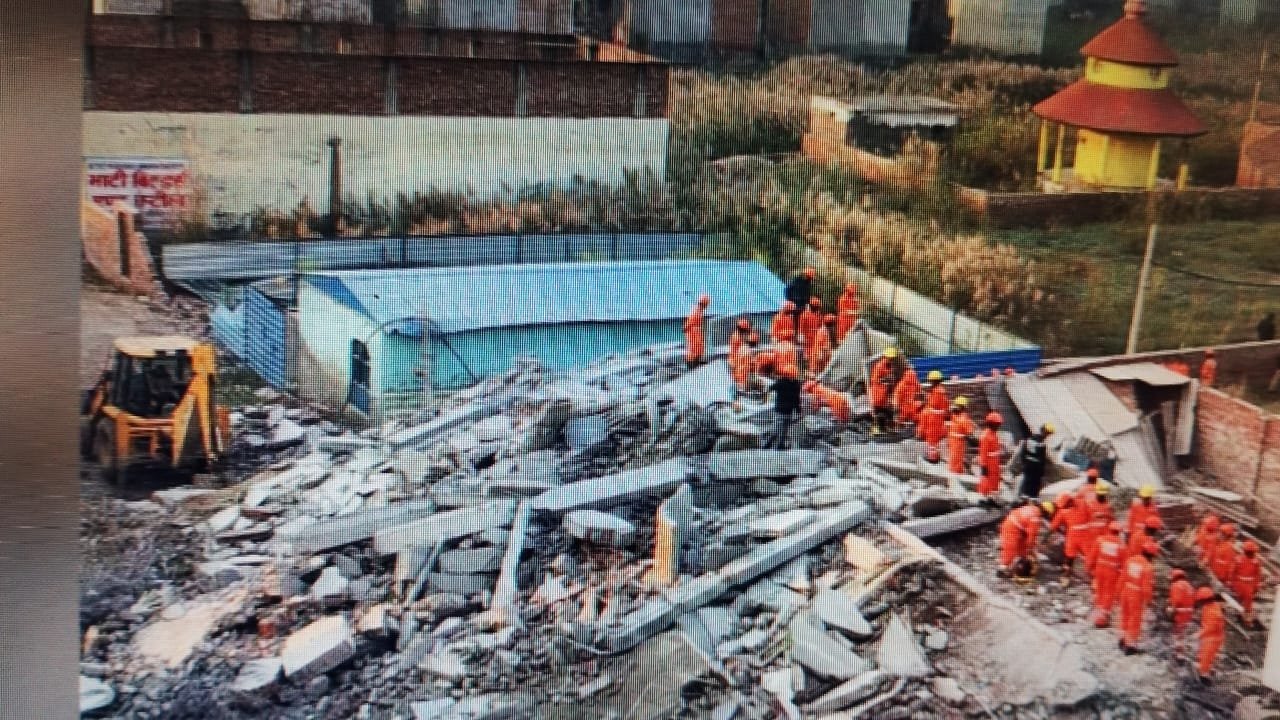
Contents
New Delhi, July 12, 2025
A tragic building collapse in the Karawal Nagar area of North-East Delhi on Saturday sent shockwaves through the region. The multi-storey structure crumbled suddenly, leaving several people injured, while a few are still feared trapped under the debris. Rescue and relief operations are currently underway at full speed.
Taking immediate note of the incident, Delhi Chief Minister Rekha Gupta has ordered a high-level investigation and directed the District Magistrate (DM) to submit a detailed report within 48 hours. Speaking to the media, she said, “Strict action will be taken against anyone found responsible for this tragedy. There can be no compromise when it comes to public safety.”
Administration Swift in Relief Operations
Teams from the NDRF and Fire Department reached the site promptly and are working tirelessly to clear the rubble. According to local residents, the building had visible cracks for quite some time, but no significant action was taken in advance.
Questions Raised Over Illegal Constructions
This incident has once again raised serious concerns about unauthorized constructions and alleged corruption in the building permit system in Delhi. The Chief Minister emphasized the need for stricter ground-level enforcement. “It’s time for the administration to act firmly against illegal structures and ensure accountability at the ward level,” she asserted.
Support and Compensation for Victims
The Delhi government has announced that it will bear the full cost of treatment for those injured in the incident. Compensation procedures for the families of the deceased have also begun. CM Rekha Gupta personally visited the hospital to meet the injured and instructed doctors to provide special care.
India
Wave of Employment Across India: Job Fairs Held in 47 Cities, 51,000 Youths Receive Appointment Letters
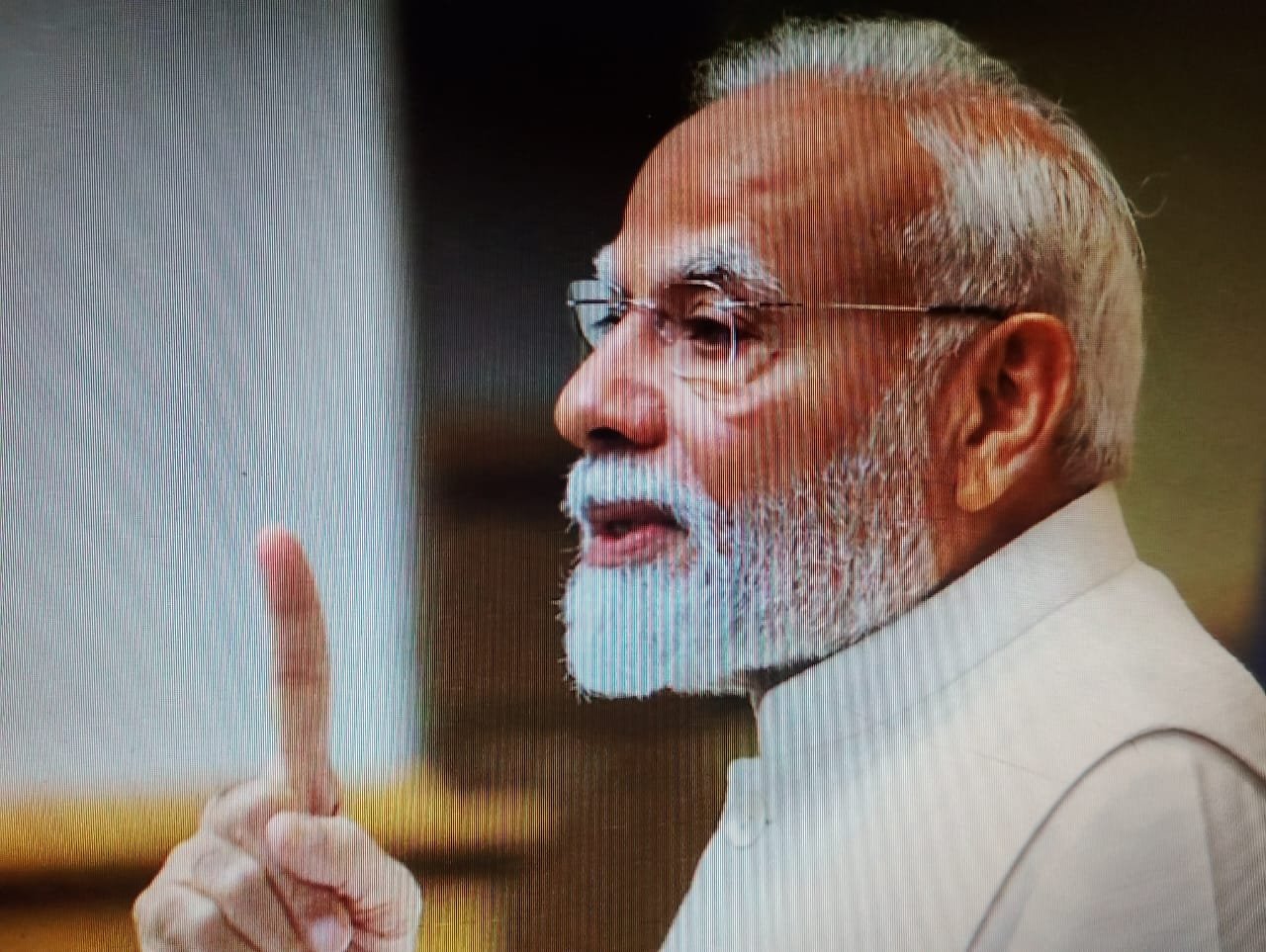
Contents
New Delhi, July 12, 2025
Saturday morning brought new hope for the youth of India as Prime Minister Narendra Modi, through video conferencing, virtually participated in employment fairs held across 47 cities and distributed over 51,000 appointment letters to newly selected candidates. These weren’t just ordinary documents—they symbolized the first step toward the dreams of thousands of young Indians, ready to build their own future.
“No Recommendations, No Bribes” — Jobs Now Based Solely on Merit
Addressing the event, Prime Minister Modi emphasized the government’s commitment to a transparent, fair, and efficient recruitment process.
“Today, jobs in India are no longer handed out through influence or favors, but through talent. This is the identity of the New India,” said PM Modi.
He further reiterated that young aspirants no longer need backing or bribes to secure government jobs. The government’s “No Recommendation, No Expense” initiative reflects this very principle.
Confidence Shines on Young Faces
One of the selected candidates from Jaipur, Rajasthan, Miss. Sharma, shared her experience with visible emotion:
“I never thought I’d get a government job without any connections or under-the-table payments. This government has made that possible. I can now see the dreams of my family shining in their eyes—and mine.”
Youth Power Will Build the Nation
The Prime Minister urged the newly recruited youth to treat their roles not just as jobs, but as opportunities for nation-building.
- “Wherever you are posted, your dedication and work ethic will shape the future of the country,” he said.
Art
Orange Day Adds a Splash of Joy at DAV Centenary Public School, Jaipur
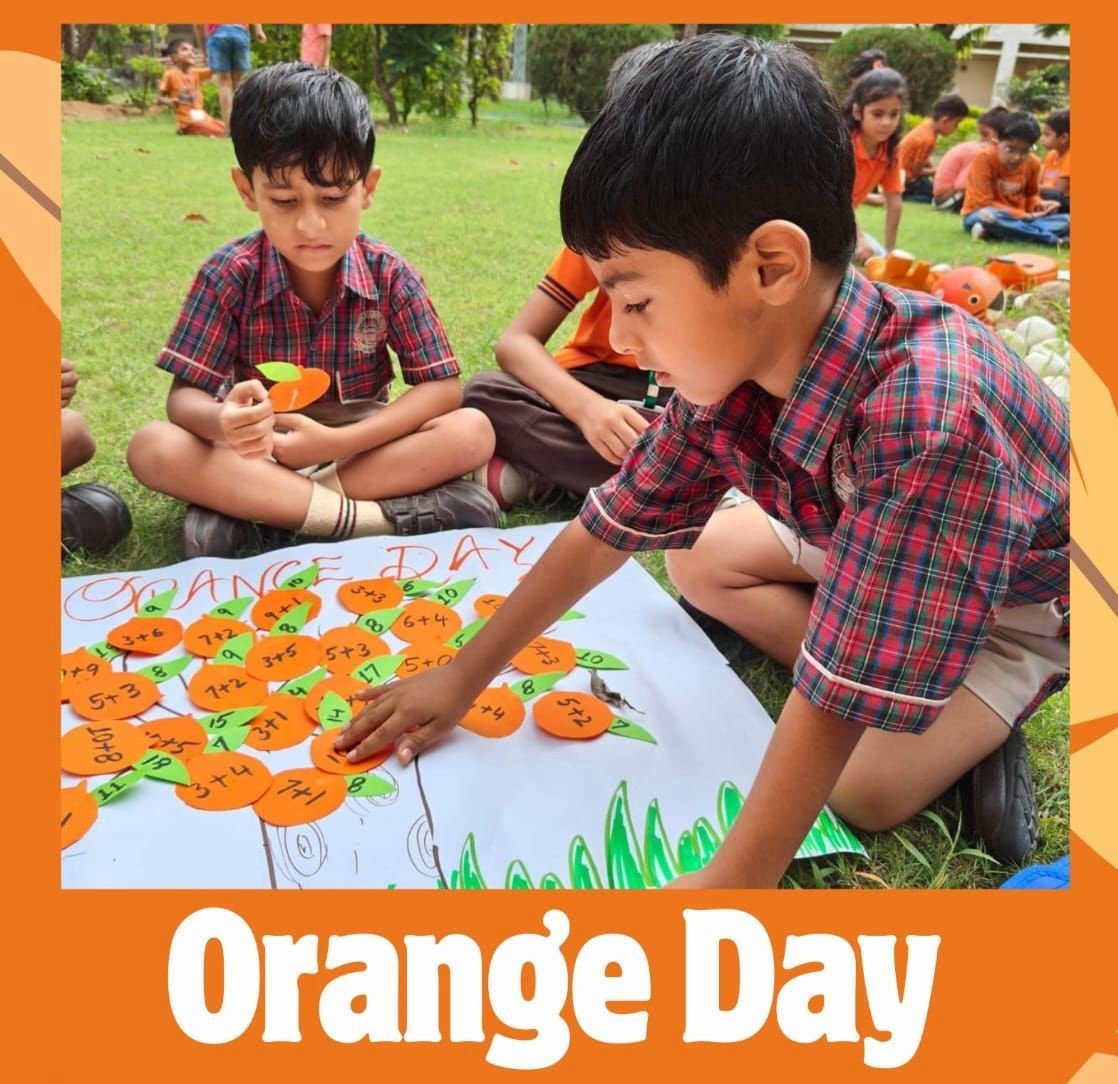
Jaipur, July 10, 2025
The tiny tots of DAV Centenary Public School, Jaipur lit up the campus as they came dressed in cheerful shades of orange to celebrate Orange Day with great excitement and enthusiasm.
The pre-primary wing turned into a lively sea of orange—from clothes and accessories to creative decorations—all reflecting the spirit of joy, creativity, and energy that the colour symbolizes. Teachers thoughtfully planned the day to help children not just enjoy, but also learn the meaning behind the colour orange—a symbol of hope, enthusiasm, and prosperity.
The classrooms were buzzing with laughter and activity as the little learners took part in various fun-filled games, storytelling, drawing, and creative expression sessions. To boost their communication skills, each child was encouraged to bring an orange-coloured object from home and speak a few lines about it in front of their classmates. For many, it was their first public speaking moment, and they did it with adorable confidence.
Principal Mr. A.K. Sharma visited the classrooms to cheer on the children. He appreciated the thoughtful planning of the teachers and said, “Activities like these help children build confidence, express themselves freely, and connect learning with real-life experiences.”
It was a delightful sight to watch the little ones bursting with curiosity, dressed in glowing orange, exploring and expressing themselves. The day left behind not just smiles and laughter, but also a colourful memory in the hearts of the young students.
Accident
Vadodara Bridge Tragedy: Death Toll Rises to 19, Two Still Missing – Rescue Operations Continue in Mahisagar River
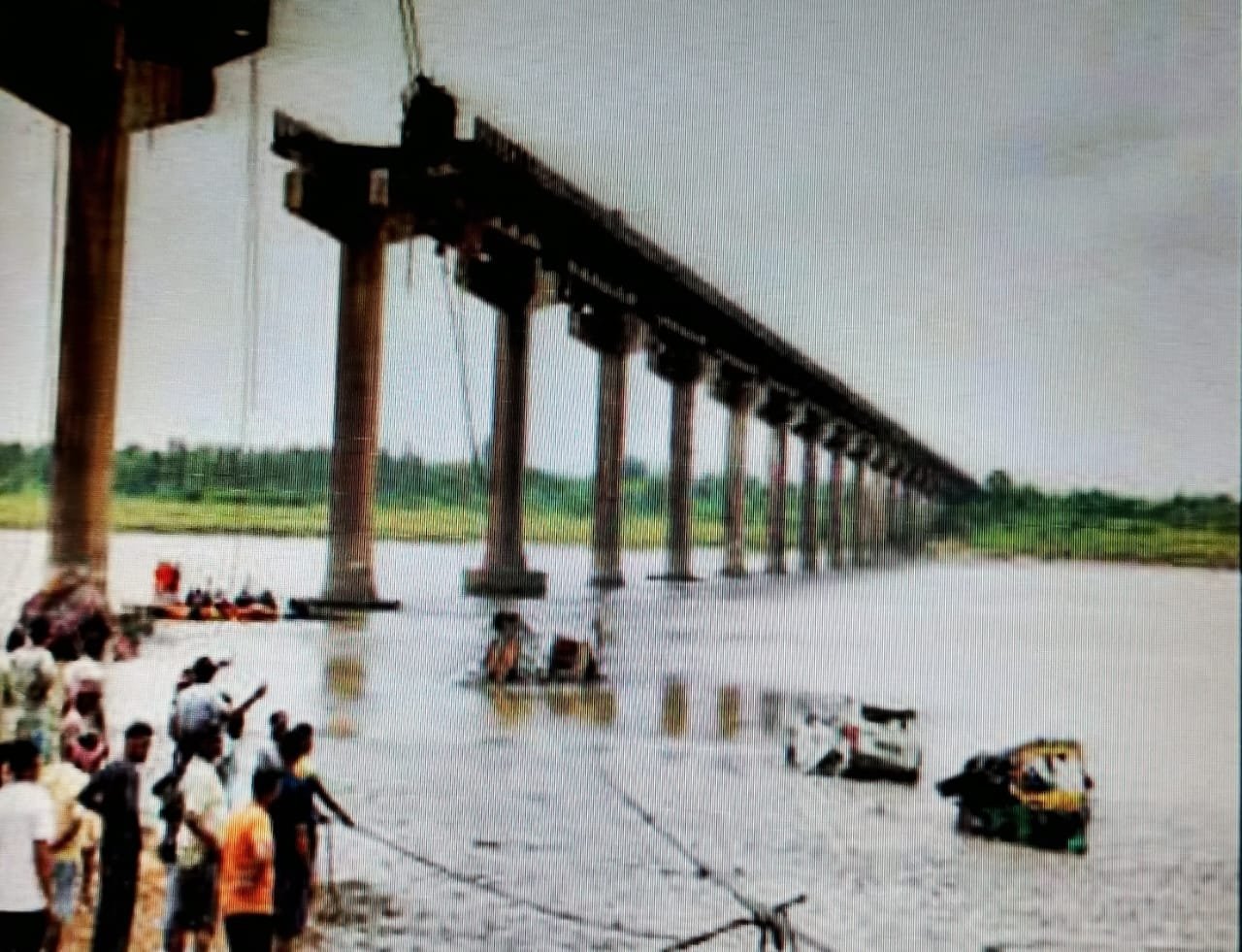
Contents
Vadodara (Gujarat), July 11, 2025
A heart-wrenching incident has shaken Gujarat as the Gambhira–Mujpur bridge over the Mahisagar River in Vadodara district collapsed unexpectedly. So far, 19 people have lost their lives, while 2 individuals remain missing. Rescue teams have been relentlessly working for the third consecutive day in the hope of saving lives and retrieving the missing.
How Did the Tragedy Happen?
The incident occurred on the morning of July 9, when several vehicles were crossing the bridge. Suddenly, a major section of the bridge collapsed into the river, dragging with it two trucks, an SUV, a pickup van, an auto-rickshaw, and two motorcycles. The bridge was nearly 40 years old, and multiple complaints had been made about its deteriorating condition.
Victims Identified, Families Devastated
So far, 18 bodies have been recovered from the debris, while one critically injured person succumbed to injuries at the hospital, taking the total death toll to 19. Among the victims were women, children, and entire families who were out on a pilgrimage for Guru Purnima.
Search Operations Still Underway
Rescue efforts by NDRF, SDRF, and fire brigade teams are still ongoing. The operation is facing major challenges due to the river’s depth, strong current, and over 10 feet of thick mud, making it difficult to access submerged vehicles. Cranes, boats, and divers are being deployed to find the two missing persons.
Government Response and Action
In the wake of the incident, the state government swiftly suspended four engineers and has ordered a detailed investigation into the bridge collapse. The government has also announced financial compensation of ₹2 lakh to the families of the deceased and ₹50,000 for the injured.
Public Outrage and Unanswered Questions
Local residents claim the bridge was already in a dangerous condition, but authorities failed to take timely action. Media reports reveal that just days before the tragedy, a journalist had posted a video highlighting the poor state of the bridge, which went ignored.
This incident has once again exposed the negligence and oversight in maintaining public infrastructure. Behind every number is a grieving family – a shattered home, a mother who lost her child, a father never to return. The need of the hour is strict accountability, immediate structural audits, and long-term corrective measures — so that such a tragedy never repeats itself.
Education
Guru Purnima Celebration at DAV CPS, Jaipur – A Heartfelt Tribute to Guiding Lights
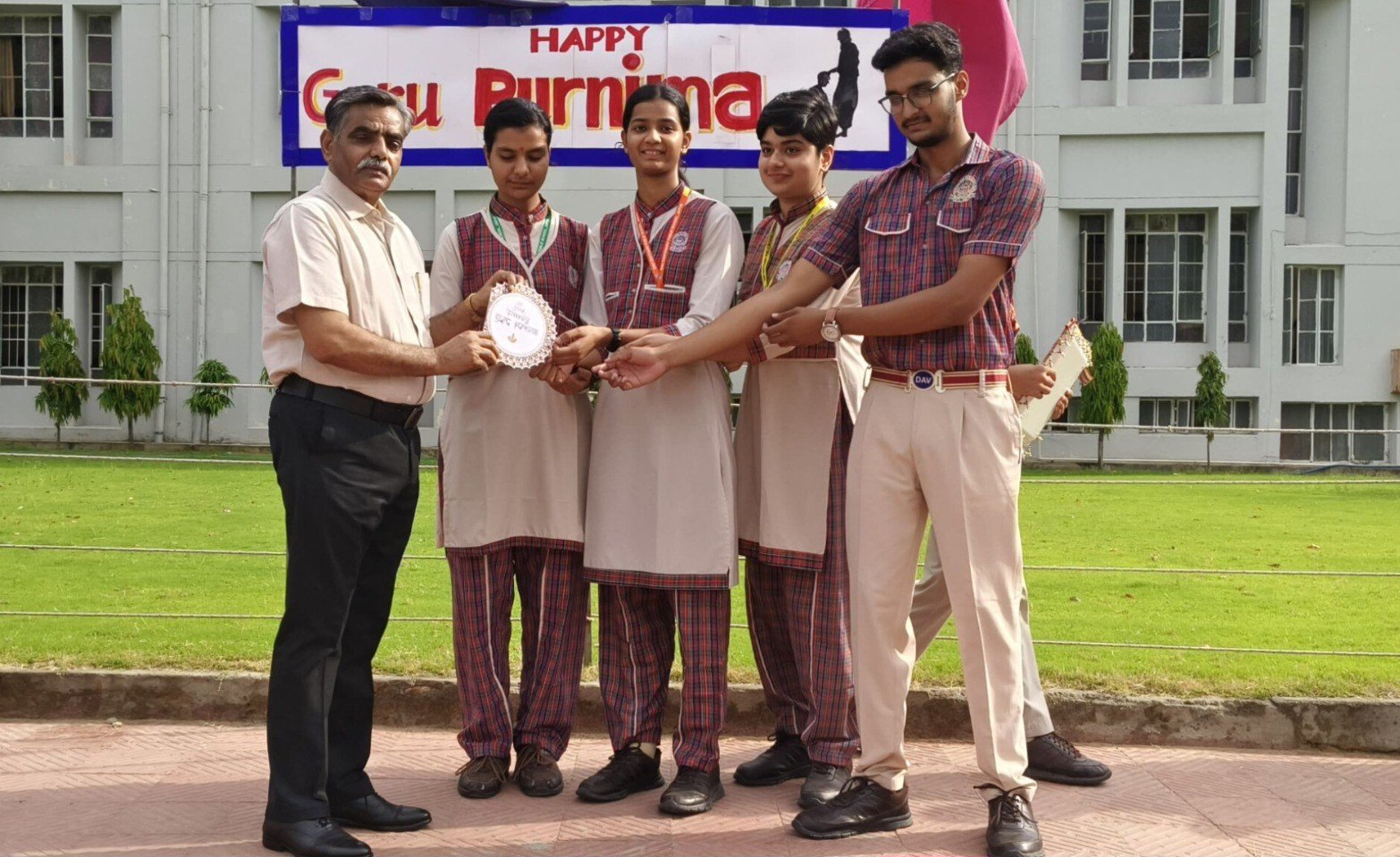
Jaipur | July 10, 2025
In an atmosphere filled with devotion, gratitude, and inspiration, DAV Centenary Public School, Vaishali Nagar, Jaipur celebrated Guru Purnima with heartfelt enthusiasm on Thursday, July 10. The event turned out to be more than just a celebration—it was a beautiful expression of love and respect for the teachers who illuminate the path of learning for their students.
The morning assembly set the tone for the day with the soothing sounds of shlokas dedicated to gurus, creating a spiritually charged environment across the campus. The essence of the celebration was beautifully captured in a speech that explained the cultural and historical roots of Guru Purnima, reminding everyone of the powerful legacy of the guru-shishya tradition.
Students poured their hearts out through soulful poems, melodious songs, and inspiring speeches, each echoing a shared sentiment—deep respect for their mentors. A mesmerizing classical dance performance, portraying devotion and reverence towards gurus, stole the spotlight and left the audience spellbound.
One of the most touching moments of the day was when the students presented a handmade gratitude card to Principal Mr. A.K. Sharma, who has been a constant source of wisdom and encouragement. In his address, Mr. Sharma reflected on the irreplaceable role of teachers in shaping young minds and urged students to stay rooted in values, discipline, and lifelong learning.
“The presence of a guru in one’s life is a blessing,” he said. “True success comes not just from knowledge, but from the humility to keep learning.”
The event concluded on a thoughtful note, leaving everyone—teachers, students, and staff—feeling more connected, more thankful, and more inspired. Guru Purnima at DAV CPS was not just an event, but an experience that reminded all of the timeless role of a teacher—not just in the classroom, but in life.
Crime
Indian Nurse to Be Hanged in 6 Days in Yemen — The Heartbreaking Story of Nimisha Priya, Who Gave Her Partner a Sedative That Turned Deadly

Contents
Thiruvananthapuram / Yemen | July11, 2025
Once a hopeful young nurse from Kerala, Nimisha Priya is now counting her final days in a Yemeni prison. Her crime — administering a sedative that led to the death of her Yemeni business partner, Alkhader Al-Omari. Her punishment — execution by hanging on July 13, 2025.
But behind this grim sentence lies a story much more complicated — one filled with ambition, control, fear, and a moment that changed everything.
A Nurse with Dreams, and a New Life Abroad
Nimisha Priya wasn’t a criminal when she left India. She was a caregiver — a skilled nurse with dreams of building a better life. In Yemen, she found work, opened a clinic, and partnered with Alkhader Al-Omari, a local man who helped her navigate the foreign land.
But what started as a partnership slowly turned into a prison.
Trapped in a Toxic Relationship
Reports from the time suggest that Al-Omari soon took control of more than just the clinic. He allegedly confiscated Nimisha’s passport, isolated her, and began mentally and physically abusing her. He took over her earnings and threatened her when she talked about returning home to India.
Far from family, friends, or legal protection, Nimisha felt completely trapped — her life and freedom in the hands of a man who, she believed, would never let her go.
The Night It All Changed
Then came that fateful night in 2017.
According to court documents, Nimisha gave Al-Omari a high dose of a sedative. Her stated intention was not to kill him, but to make him unconscious, retrieve her passport, and escape. But the sedative proved too strong — Al-Omari died.
Panic set in. Nimisha reportedly dismembered his body and tried to hide the evidence in a water tank. A gruesome and desperate act that, once discovered, left her no room to explain.
A Death Sentence, and a Race Against Time
The Yemeni court ruled the act pre-meditated murder and sentenced Nimisha to death by hanging.
For years, legal teams in India and Yemen pleaded for clemency. Activists pointed to the abuse she suffered, to the desperation of a woman with no escape, and to her otherwise clean record. Her mother, in tears, begged the Yemeni family for forgiveness, hoping for a “Diya” — blood money — a custom in Yemen that allows the victim’s family to pardon the accused.
But that pardon never came.
Only Six Days Left…
Today, Nimisha Priya is a prisoner not just behind bars, but in time. With just six days left, she awaits her execution. Her mother is still trying — hoping against hope — for one final miracle.
Meanwhile, millions in India are asking:
Was she a murderer? Or a victim of circumstance, trying to survive in a world where no one came to help?
Beyond the Verdict
This is not just Nimisha’s story. It’s the story of thousands of Indian women who work abroad, often with little protection. It’s the story of how desperation can drive someone to the edge, and how the law — especially in foreign lands — rarely leaves room for the grey in between.
Crime
India’s Biggest Scam You Never Heard Enough About — ₹49,000 Crore Vanished, 5 Crore Lives Shattered, And Now… One Big Arrest

Contents
Lucknow | July 11, 2025
In what could be one of the biggest financial frauds in India’s history, the curtain has finally started to lift. The Uttar Pradesh Economic Offences Wing (EOW) has arrested Gurnam Singh (69) — the key director behind Pearls Agrotech Corporation Ltd (PACL) — from Punjab’s Ropar district.
His crime? Allegedly orchestrating a ₹49,000 crore Ponzi scheme that duped nearly 5 crore investors across India.
This wasn’t just about money. It was about dreams sold and lives broken — mostly belonging to farmers, small shopkeepers, daily wage workers, and middle-class families who trusted PACL with their hard-earned savings.
The Dream That Turned Into a Trap
PACL promised affordable land investments. The plan sounded simple — invest now, and in a few years, you’d either get a valuable land parcel or high returns.
But behind the glittering promises lay a hollow scam.
No land. No returns. Just a web of false paperwork and delayed answers — until one day, even those stopped.
EOW’s New Face — Tough, Accountable, and On a Mission
What’s changed now? The UP EOW has introduced a “Reward and Punish” system to fast-track major financial crime probes like this:
- Monthly performance tracking of officers
- Fast-track teams deployed in every district
- Seizure of properties under Section 111 of the new BNS law
- Helplines, awareness drives, and social media alerts for public support
This new system has already led to 14 arrests, including key names linked to the ₹250 crore V-Care scam and this massive PACL fraud.
This Isn’t Just About Money — It’s About Betrayal
One woman investor said it best:
“We saved for our children’s education, for their future. Now we run around courts and collector offices, with nothing to show for it.”
Behind every number in this scam — there’s a family. A broken promise. A shattered future.
The Bigger Picture
This arrest proves one thing: Justice may be slow, but it’s not blind. ₹49,000 crore didn’t just disappear — it was siphoned off through trust and illusion. The real question now is:
Will India’s legal system bring back justice and money for 5 crore defrauded citizens? Or will this case too fade into the dust of files and forgotten hearings?
India
India Crosses 1.46 Billion — But Why Are People Having Fewer Children? UN Report Reveals the Changing Math of Population

Contents
New Delhi | July11, 2025
There was a time when India’s growing population was considered the country’s biggest problem. Slogans like “Hum Do, Hamare Do” (We Two, Our Two) echoed across walls and radio channels. But times have changed — and so has the narrative.
According to the latest report by the United Nations, India’s population has officially crossed 1.46 billion, making it the most populous nation on the planet. But what’s surprising is this: India’s fertility rate — the number of children a woman has — is steadily declining.
Today, the average Indian woman is giving birth to just two children, which is right around the replacement level needed to maintain a stable population.
So, if fewer children are being born, why is the population still rising? What’s really happening behind these numbers?
This Isn’t Just About Statistics — It’s a Social Shift
There was a time when India was labelled a “population bomb.” Now, several Indian states — including Kerala, Delhi, Tamil Nadu, Karnataka, and Punjab — have fertility rates below replacement level.
This isn’t happening due to force or law — but through education, awareness, and personal choice. It’s a quiet revolution led by society itself.
India is now slowly moving towards population stability, something once thought to be decades away.
Women Are Leading This Change
Behind these shifting numbers is a bigger story — the story of India’s changing women:
- They’re more educated
- They’re joining the workforce
- They’re marrying later
- And they’re making thoughtful, conscious decisions about motherhood
Children are no longer just a tradition — they’re a planned responsibility.
India’s Population Will Peak by 2060 — Then Begin to Decline
Experts say this population growth is the result of demographic momentum — a situation where the current large number of young people continues to reproduce, even as fertility falls.
But once this momentum slows, India’s population will gradually start to decline — marking the beginning of a new era.
That means: the country that is the youngest today may one day become one of the oldest nations in terms of age demographics.
The Real Question Now: What Will We Do With So Many People?
- Can we create enough jobs for all?
- Will our education and healthcare systems be able to handle the pressure?
- And when the population begins to shrink, who will take care of the elderly?
India now needs smart policies, not just to control numbers — but to improve the quality of its population. Because in the long run, it’s not just about how many people we have, but what those people can do.
The Population Game Has Changed
This UN report isn’t just another document filled with stats — it’s a signal that India is entering a new demographic era.
The country is slowly shifting its focus from “how many” to “how capable” — and that’s where real progress begins.
Crime
Shocking Crime in Gurugram: Rising Tennis Star Radhika Yadav Shot Dead — Father Pulls the Trigger Over Career Dispute

Contents
Gurugram | July 11, 2025
In a deeply disturbing incident that has sent shockwaves across Gurugram, 21-year-old national tennis player Radhika Yadav was shot dead in her own home on Sunday morning. The most heartbreaking detail? The shooter was none other than her own father.
Radhika, who had made a mark at the national level in the past two years and had recently been selected for an international tournament, was the pride of her neighborhood. But her promising journey was cut short not by a stranger, but by someone who was supposed to protect her — her father, Ravindra Yadav.
What led to the tragic shooting?
According to initial police reports, Ravindra Yadav confessed during interrogation that he shot Radhika “in a fit of rage.” Investigators reveal that Radhika was passionate about her tennis career and was preparing to travel abroad for further training and competitions — a plan that reportedly didn’t sit well with her father.
Sources close to the family say Ravindra had always been a strict and conservative man. He was uncomfortable with Radhika’s growing independence and career choices. Tensions had been simmering within the household for months. On Saturday night, a heated argument broke out, and by morning, the unthinkable had happened.
Community in shock
The neighborhood is still reeling from the tragedy. Neighbors describe Radhika as a humble, focused, and highly disciplined young woman.
“She would be out for practice every morning by 5 AM. That kind of dedication is rare these days,” said one neighbor, struggling to hold back tears.
Father arrested on the spot
Police arrested Ravindra Yadav at the scene. He has been charged with murder under relevant sections of the IPC. Radhika’s mother, who was reportedly present in the house during the incident, is in deep shock and under medical observation.
A nation reflects: Are dreams still a crime for daughters?
Radhika’s brutal murder has sparked widespread outrage and grief. It has reignited an uncomfortable question — are daughters still being punished for dreaming big?
When a father turns into the very obstacle his daughter must overcome, it’s a mirror held up to our society.
Latest News
Swiss Accounts, Conversion Racket, and Trapped Innocents — This Wasn’t a Saint, He Was a Predator
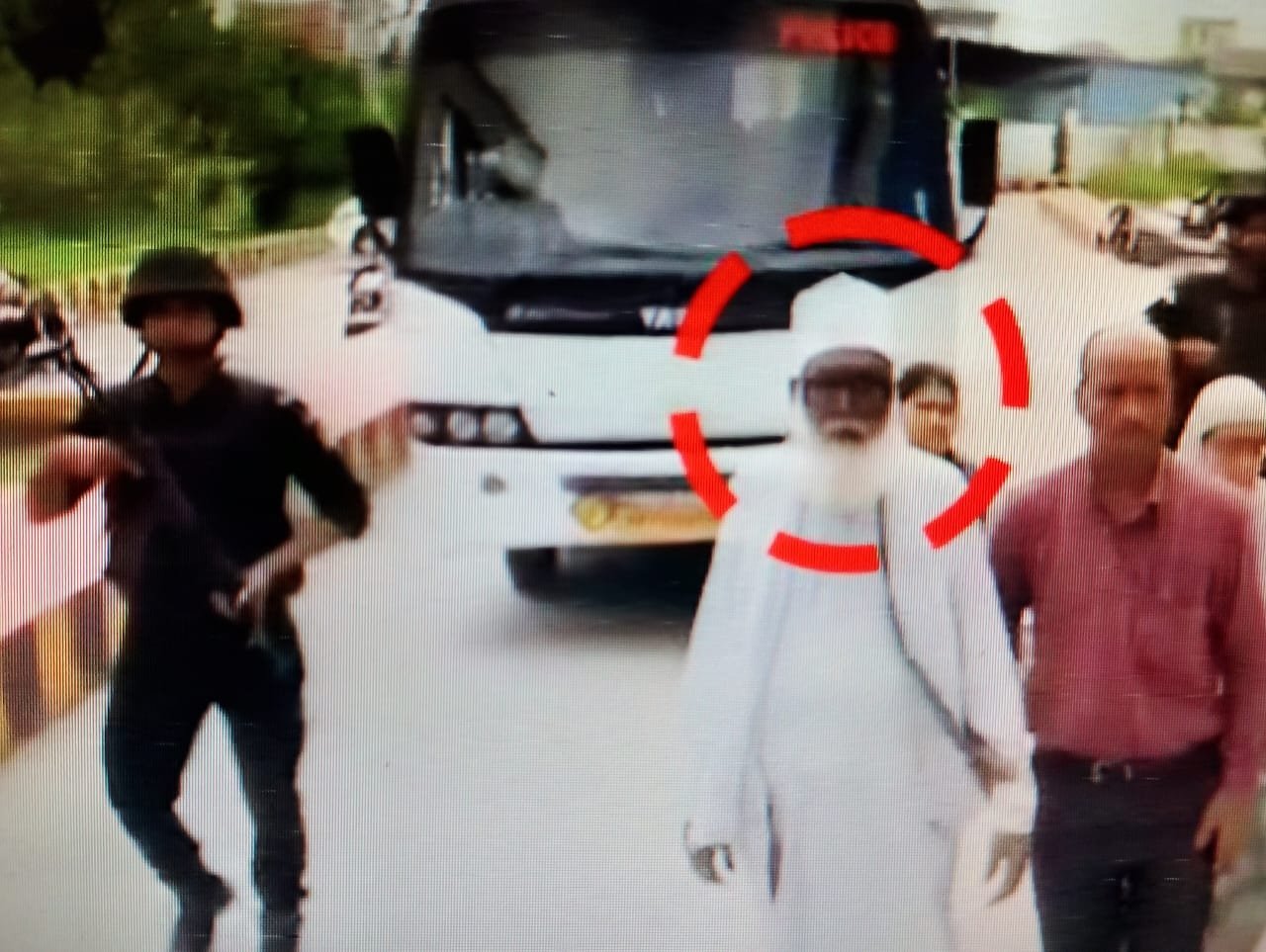
Contents
Uttar Pradesh | 11 July 2025
By Credent TV News Desk
He walked with a staff, wore a long beard, and people in the village folded their hands in reverence at his feet. But behind that saintly image was a man running one of the darkest religious conversion syndicates India has ever seen. His name: Changur Baba. Real name: Jalaluddin. Age: 70. And his list of crimes? Long enough to outlive his age.
A Full-Fledged Conversion Industry
Recent investigations by Uttar Pradesh STF and ATS have uncovered a deeply disturbing reality. This so-called baba wasn’t just chanting prayers — he was masterminding an elaborate system of trapping women and girls into forced religious conversions.
His targets? Minor girls, widows, and poor women — the most vulnerable in society.
His method? Manipulation, emotional blackmail, fake promises of marriage, and when that didn’t work — threats and money.
What’s even more shocking — Baba had a conversion training manual. A complete system of how to trap girls from different religions: what to say, when to act affectionate, and when to threaten.
Fixed rates were decided for each conversion. This wasn’t faith — it was business.
Crores in Swiss Bank Accounts
If you thought this racket was operating on a small scale, think again. Investigators discovered over 40 bank accounts linked to Changur Baba, including several in Switzerland. The total transactions? A staggering ₹106 crore (over $12 million).
Where did the money come from? Sharjah, Dubai, and other Islamic countries, according to the STF.
This was not just a religious racket — it was internationally funded and systematically operated.
Arrested — But the Net Is Wider
On 5th July, STF arrested Changur Baba along with his close aide, Neetu alias Nasreen, from a hotel in Lucknow. During interrogation, it was revealed that the network stretched far — from Mumbai to Dubai.
Now, the Enforcement Directorate (ED) has joined the investigation. A money laundering probe is underway, and authorities are preparing to seize assets and properties linked to the illegal trust and conversions.
A Saint No More
Changur Baba may be behind bars now, but the emotional scars he left on thousands of innocent women can’t be counted in case files or spreadsheets.
He exploited faith to deceive, used trust to destroy, and wore religion as a mask for crime.
As one STF officer said:
“He wasn’t a saint in White. He was a predator in disguise.”
The villagers who once bowed before him now raise questions. How did this go on for so long? And how many more like him are out there?
There’s an old saying:
“When fake saints rise, truth becomes the biggest casualty.”
But this time, the law has spoken. And Baba’s mask has finally fallen.

 Education1 month ago
Education1 month agoKota ICICI Bank Staffer Swindles ₹4.5 Crore, Gambles It All on Stock Market

 Education2 weeks ago
Education2 weeks ago11 Powerful Reasons Why DAV International Yoga Day Jaipur Uplifted Spirits!

 Bollywood1 month ago
Bollywood1 month agoHousefull 5 Movie Review: Akshay Kumar, Riteish Deshmukh Bring Laughter and Twists in Bollywood’s Biggest Comedy Franchise

 Cricket1 month ago
Cricket1 month agoBengaluru Chinnaswamy Stadium Stampede: 11 Dead, 33 Injured in RCB Victory Parade Chaos

 Education2 weeks ago
Education2 weeks ago7 Inspiring Highlights of DAV Foundation Day Jaipur Celebration – Amazing Vedic Legacy Revealed!

 Education2 weeks ago
Education2 weeks agoEmpowering Educators: A Three-Day Learning Journey at DAV Centenary Public School, Jaipur

 Credent TV2 weeks ago
Credent TV2 weeks agoVIBGYOR Summer Camp Ends on a High at DAV Centenary Public School, Jaipur

 Election4 days ago
Election4 days agoDAV Centenary Public School, Vaishali Nagar, Jaipur Event Report: Talent Hunt Show
































